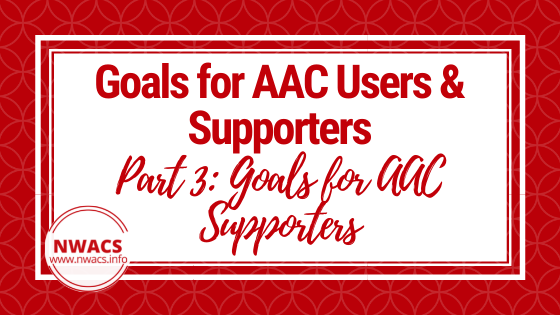by Penny Tonn, MS, CCC-SLP (Speech-Language Pathologist); NWACS Contributor
This is Part 3 of a three part series. If you have not read Part 1 yet, go read it HERE, and Part 2 HERE.
AAC is most effective with a team approach. Teams include the AAC user, their caregivers, and other support people. When developing AAC goals, teams should be aware of the communication needs of the person. They should also think about team member knowledge of AAC and the AAC system used.
Goals for AAC Supporters
Although supporting AAC users is important, it is also critical to support other team members. Caregivers and others within the circle of support should model AAC use for the AAC user. Without experience with AAC through engagement, the onus of learning AAC is on the user. We learn language through our experiences. So we can support caregivers by teaching them some of the following skills:
How is the device set up? How can we program new buttons, hide vocabulary if needed, and individualize the system?
What is motivating for the AAC user? What situations will be the most enjoyable? If the AAC user loves physical movement, commenting during play at the park will be a great time to model words and word combinations such as “swing”, “swing high”, or “push me”. Identify some situations that interactions are motivating and make a plan to model language using the AAC system.
What words should I model? Identify words and word combinations that fit within enjoyable activities and model using AAC during these activities. Remember to focus on a variety of communicative functions. Sometimes you may model exclamations of enjoyment or displeasure, or you may find yourself sharing experiences after the fun activity, like “Park fun!”.
Here is a link to some additional strategies for caregiver support in AAC use: 10 Strategies to Train Parents and Improve Carryover for Students Using AAC
For additional resources on building AAC goals, check out this previous NWACS blog Back to School with the DAGG-2 — NWACS!
The communicative competencies in AAC can also be a helpful guide for developing AAC goals. Check out this first post in a series on the NWACS blog: Communicative Competence
What other goals do you think are important for AAC users and their support systems? Share your ideas and experiences in the comments or the NWACS Facebook page!
Related posts:
Goals for AAC Users and Supporters - Part 2: Goals for Dynamic Systems




